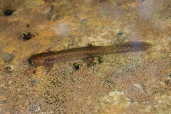Kanawha Blackbelly Salamander (Desmognathus kanawha)
Description: This species has a very frog-like face, with large eyes that are set very forward on their head. Their back has a unique orange and black camouflage-type patterns, often with two rows of orange, lateral spots that fade with age. They usually have a row of sub-lateral spots down the flanks or a granite texture. Their tail is noticeably flat, and keeled.
Habitat: In or along swift, boulder-strewn mountain streams. Also near waterfalls and places where cold water drips or seeps. Refuges are in rock cevices or in burrows. Usually under rocks in daytime. Sometimes basks in sun on wet rocks. Eggs are laid on undersides of rocks or on tree roots in streambed, apparently in headwater tributaries in North Carolina..
Range: This species occurs primarily in the Kanawha River drainage of Virginia and West Virginia, with populations in the drainages of the Upper Pee Dee of North Carolina and Virginia, the Upper Tennessee of southwestern Virginia and potentially adjacent northeastern Tennessee, the Roanoke of north-central North Carolina and south-central Virginia, and the Lower Chesapeake of west-central Virginia. The southwestern and northeastern distributional extents of this species are unknown.
Found in these States:
NC |
VA |
WV
Diet: Eats insects, snails, and small salamanders; aquatic prey dominate diet of larvae; adults eat substantial amounts of both aquatic and terrestrial prey. Largely an ambush predator.
Reproduction: Lays up to about 60 eggs in June to July, singly or in cluster. Female remains with eggs until hatching. In Virginia, aquatic larvae hatched in August-September, metamorphosed in 2 years; larval period was 3 to 4 years (sometimes 2 years) in North Carolina. In northeastern Georgia, hatching occurred in July, and the larval period lasted 3 or 4 years, depending on location. In North Carolina, age of first reproduction was estimated at 9 to 10 years in females and 7 to 8 years in males.
Status: (Based on D. quadramaculatus): Listed as Least Concern in view of its wide distribution and presumed large population.
Taxonomy: Initially grouped with the blackbelly salamander (D. quadramaculatus), a 2022 study found significant genetic divergence within the species, but also found that the name D. quadramaculatus had in fact been coined for the northern dusky salamander rather than the blackbelly salamander. The northern population was thus described as a distinct species, D. kanawha, after the Kanawha basin.
Taxonomic Split 112588 (Committed on 09-26-2022): Desmognathus quadramaculatus split into Desmognathus amphileucus, Desmognathus kanawha, Desmognathus gvnigeusgwotli, & Desmognathus mavrokoilius
»» Kingdom: Animalia - Animals
»» Phylum: Chordata - Chordates
»» Subphylum: Vertebrata - Vertebrates
»» Class: Amphibia - (Amphibians)
»» Order: Caudata - Salamanders
»» Family: Plethodontidae - Lungless Salamanders
»» Subfamily: Hemidactyliinae - Hemidactyliine Salamanders
»» Genus: Desmognathus
»» Species: Desmognathus kanawha - Kanawha Blackbelly Salamander
This article uses material from the Wikipedia article "Desmognathus", which is released under the Creative Commons Attribution-Share-Alike License 3.0. Content may have been omitted from the original, but no content has been changed or extended.
|








